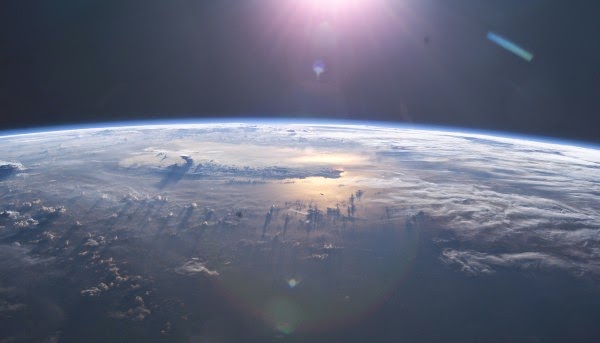
The rise of oxygen is one of the biggest puzzle in Earth’s history. Our planet’s atmosphere started out oxygen-free. Then, around 3.5 billion years ago, tiny microbes called cyanobacteria (or blue-green algae) learned out to carry out photosynthesis. They began using energy from sunlight to make their food from carbon dioxide and water, giving off oxygen as waste.
But it took another 3 billion years for oxygen levels to climb from trace amounts to at least 20 percent of the atmosphere, or high enough to support the emergence of complex life. And so far the mechanism behind that rise has remained unclear.
Now a new study by University of Exeter biochemist Benjamin Mills and his colleagues offers a new potential clue.
Using a computer model, they showed that plate tectonics may have indirectly fueled the sharp increase in oxygen between 1.5 billion and half a billion years ago. In particular, a process tied to the way continents remove carbon dioxide from the atmosphere may have increased the supply of phosphorus, a key nutrient for photosynthetic microbes in the ocean. The paper was published this month in the Proceedings of the National Academy of Science.
“This is a novel perspective for the late Proterozoic—a critical time of dramatic climate change, rising oxygen in the ocean and atmosphere, and origins and diversification of complex life,” says Timothy Lyons, a biogeochemist not involved in the study.
From Seafloor to Terrestrial “Weathering’
Continents play a crucial role in the carbon cycle by removing carbon dioxide from the atmosphere. Carbon dioxide mixes with rain water, forming a weak acid (carbonic acid) which slowly wears down or “weathers” rocks on land.
The process releases minerals such as calcium and magnesium from the rocks. These minerals then combine with carbonate and settle at the bottom of the ocean forming layers of calcium carbonate, or limestone.
In other words, the weathering process simply pulls carbon from the atmosphere and turns it into a layer of sediment on the seafloor.
However, continental rocks aren’t the only route by which carbon is removed from the atmosphere. Ocean ridges, the places where fresh crust is made on the seafloor, can undergo a similar “weathering” process. In fact, seafloor weathering was the main route of carbon removal in the early chapter of Earth’s history, before the formation of continents.
According to the new study, the rise of oxygen may have been due to a shift in balance between the two processes—between seafloor and continental weathering.
Potential Culprits
What caused that shift? The model looked at two factors: a brighter sun, and a slowdown in fresh crust production.
Our sun has slowly been getting brighter. It’s now 20 to 30 percent brighter than when our Earth first formed. Because the weathering process depends on temperature, a brighter Sun may have sped up the process on land. What’s more, the amount of fresh ocean floor formed has slowed down over time. And the weathering process generally happens with the newer crust. Taken together, these two factor may have shifted the balance between the seafloor and the terrestrial process.
The Phosphorus Boost
But why does that shift matter? “Rocks on continents contain phosphorus, which is a key limiting nutrient for photosynthetic microbes,” Mills says.
The terrestrial weathering increases the amount of phosphorus in streams and rivers, and ultimately in the ocean. The amount of phosphorus then dictates how much photosynthesis, hence how much oxygen is produced.
“The paper a great step forward,” says Lyons. “The fundamental mechanistic perspective, particularly the co-consideration of seafloor and continental processes, is broadly relevant and clever.”
One drawback, though, Lyons says, is that the model doesn’t account for the shorter-term variations of oxygen’s up and down. “The model, as proposed, isn’t able to explain the details of the transition,” Lyons adds. “But overall it still support the long term increase in oxygen.”
Implications for Astrobiology
The study provides an indirect link between plate tectonic and continents on one hand and the evolution of complex life on the other, an idea worth keeping in mind in the search for life beyond our world.
“This is not the only reason oxygen rose to high levels, but it seems to be an important piece of the puzzle. Whilst the carbon cycle can function without large continents, it seems that their emergence was critical to our own evolution,” Mills says in a news release.
Mills later adds in a phone interview:
“A large number of key limiting nutrients, and not just phosphate, come from the continents. It seems that to develop a biosphere like we have on this planet, you’re going to need significant continental area.”
In fact, the recycling of continents via plate tectonics has become of major interest for many astrobiologists. Several have argued that, along with water, plate tectonics could be an essential requirement for life.
“What I like in particular is the rigorous links between tectonic drivers and oxygen (and life by association), which must be a considered in any view of extrasolar planets and their ability to sustain life through nutrient balances—with oxygenation as a possible consequence,” Lyons adds. “Plate tectonics and relationships to nutrient cycling, phosphorus in particular, should be an essential part in any exploration for life—on the early Earth and farther from home.”
More information:
Benjamin Mills, Timothy M. Lenton, and Andrew J. Watson. “Proterozoic oxygen rise linked to shifting balance between seafloor and terrestrial weathering.” PNAS 2014 ; published ahead of print June 9, 2014, DOI: 10.1073/pnas.1321679111
Note : The above story is based on materials provided by courtesy of NASA’s Astrobiology Magazine. Explore the Earth and beyond at Astrobio.net










